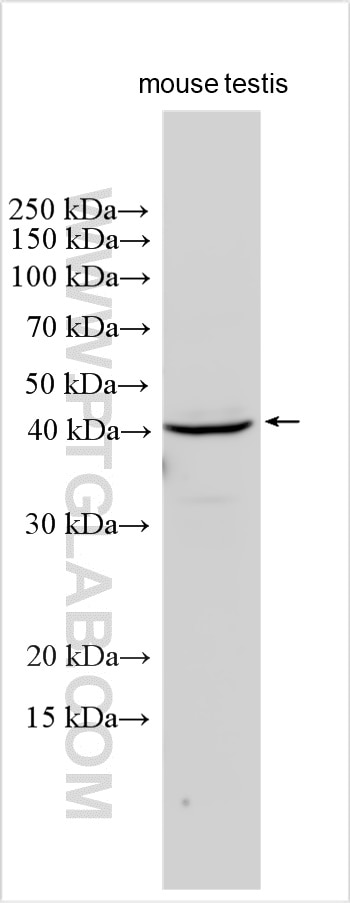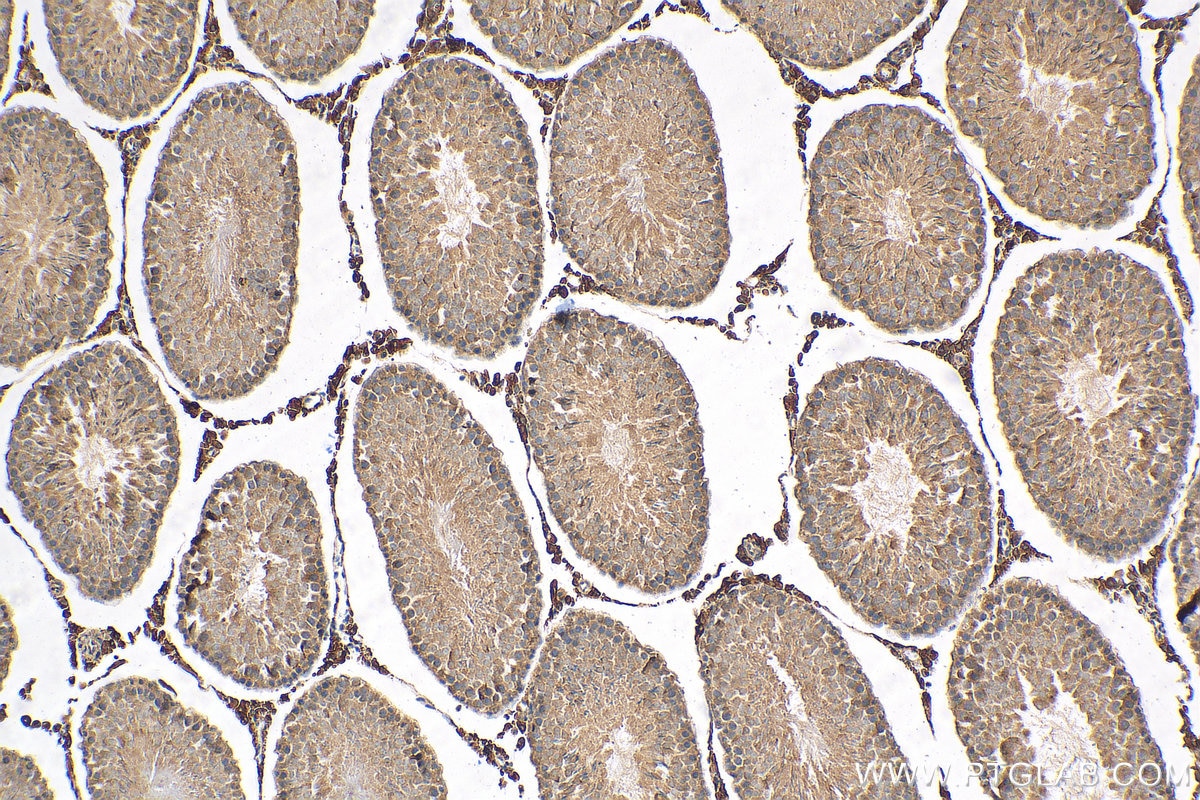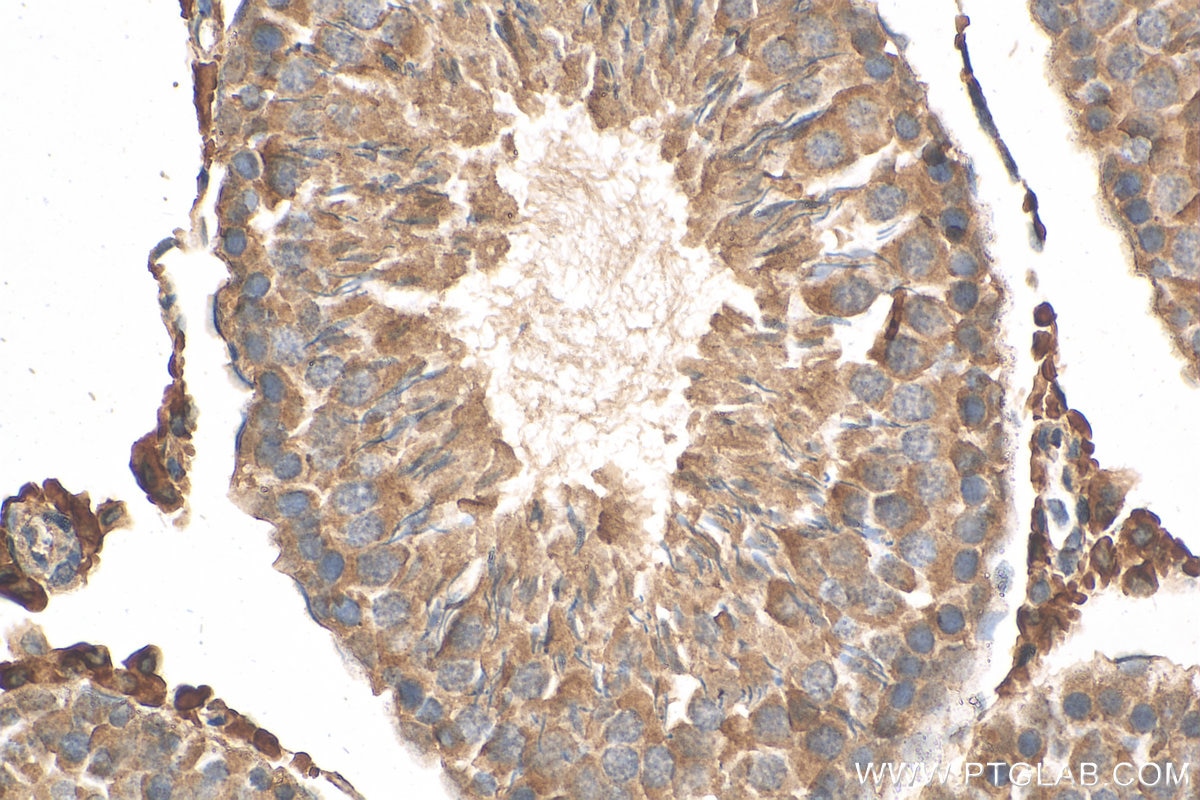HSD3B2 Polyklonaler Antikörper
HSD3B2 Polyklonal Antikörper für IHC, WB, ELISA
Wirt / Isotyp
Kaninchen / IgG
Getestete Reaktivität
human, Maus, Ratte und mehr (1)
Anwendung
WB, IHC, IF, ELISA
Konjugation
Unkonjugiert
Kat-Nr. : 15516-1-AP
Synonyme
Galerie der Validierungsdaten
Geprüfte Anwendungen
| Erfolgreiche Detektion in WB | Maushodengewebe |
| Erfolgreiche Detektion in IHC | Rattenhodengewebe Hinweis: Antigendemaskierung mit TE-Puffer pH 9,0 empfohlen. (*) Wahlweise kann die Antigendemaskierung auch mit Citratpuffer pH 6,0 erfolgen. |
Empfohlene Verdünnung
| Anwendung | Verdünnung |
|---|---|
| Western Blot (WB) | WB : 1:1000-1:5000 |
| Immunhistochemie (IHC) | IHC : 1:50-1:500 |
| It is recommended that this reagent should be titrated in each testing system to obtain optimal results. | |
| Sample-dependent, check data in validation data gallery | |
Veröffentlichte Anwendungen
| WB | See 3 publications below |
| IHC | See 3 publications below |
| IF | See 1 publications below |
Produktinformation
15516-1-AP bindet in WB, IHC, IF, ELISA HSD3B2 und zeigt Reaktivität mit human, Maus, Ratten
| Getestete Reaktivität | human, Maus, Ratte |
| In Publikationen genannte Reaktivität | human, Hund, Maus, Ratte |
| Wirt / Isotyp | Kaninchen / IgG |
| Klonalität | Polyklonal |
| Typ | Antikörper |
| Immunogen | HSD3B2 fusion protein Ag7782 |
| Vollständiger Name | hydroxy-delta-5-steroid dehydrogenase, 3 beta- and steroid delta-isomerase 2 |
| Berechnetes Molekulargewicht | 42 kDa |
| Beobachtetes Molekulargewicht | 42 kDa |
| GenBank-Zugangsnummer | BC038419 |
| Gene symbol | HSD3B2 |
| Gene ID (NCBI) | 3284 |
| Konjugation | Unkonjugiert |
| Form | Liquid |
| Reinigungsmethode | Antigen-Affinitätsreinigung |
| Lagerungspuffer | PBS mit 0.02% Natriumazid und 50% Glycerin pH 7.3. |
| Lagerungsbedingungen | Bei -20°C lagern. Nach dem Versand ein Jahr lang stabil Aliquotieren ist bei -20oC Lagerung nicht notwendig. 20ul Größen enthalten 0,1% BSA. |
Hintergrundinformationen
HSD3B2(3-beta-hydroxy-Delta(5)-steroid dehydrogenase) belongs to the 3-beta-HSD family and catalyzes the oxidation and isomerization of delta-5-3-beta-hydroxysteroid precursors into delta-4-ketosteroids, thus leading to the formation of all classes of steroid hormones.HSD3B2 is expressed almost exclusively in adrenals and gonads, whereas HSD3B1 is expressed predominantly in placenta and skin (PMID:1682237). HSD3B2 plays a crucial role in steroid hormone biosynthesis and is thus of particular interest in hormone dependent tumors such as prostate cancer. Compared with normal tissue cytoplasmic HSD3B2 staining was stronger in prostate cancers (PMID: 29803408). Defects in HSD3B2 are the cause of adrenal hyperplasia type 2 (AH2).
Protokolle
| Produktspezifische Protokolle | |
|---|---|
| WB protocol for HSD3B2 antibody 15516-1-AP | Protokoll herunterladen |
| IHC protocol for HSD3B2 antibody 15516-1-AP | Protokoll herunterladen |
| Standard-Protokolle | |
|---|---|
| Klicken Sie hier, um unsere Standardprotokolle anzuzeigen |
Publikationen
| Species | Application | Title |
|---|---|---|
J Hazard Mater Tributyltin chloride (TBTCL) induces cell injury via dysregulation of endoplasmic reticulum stress and autophagy in Leydig cells | ||
Oncotarget Generation and characteristics of human Sertoli cell line immortalized by overexpression of human telomerase. | ||
Endocrinology A dietary medium-chain fatty acid, decanoic acid, inhibits recruitment of Nur77 to the HSD3B2 promoter in vitro, and reverses endocrine and metabolic abnormalities in a rat model of polycystic ovary syndrome. | ||
Front Physiol Long-Term Maintenance and Meiotic Entry of Early Germ Cells in Murine Testicular Organoids Functionalized by 3D Printed Scaffolds and Air-Medium Interface Cultivation. | ||
Reprod Biomed Online Brain-derived neurotrophic factor expression in granulosa lutein cells. | ||
Int J Clin Exp Pathol Ectopic cortisol-producing adrenocortical adenoma in the renal hilum: histopathological features and steroidogenic enzyme profile. |




